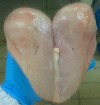Muscle growth and poultry meat quality issues
- PMID: 22347614
- PMCID: PMC3277097
- DOI: 10.3390/nu4010001
Muscle growth and poultry meat quality issues
Abstract
Over the past 50 years the worldwide growing demand of poultry meat has resulted in pressure on breeders, nutritionists and growers to increase the growth rate of birds, feed efficiency, size of breast muscle and reduction in abdominal fatness. Moreover, the shift toward further processed products has emphasized the necessity for higher standards in poultry meat to improve sensory characteristics and functional properties. It is believed that genetic progress has put more stress on the growing bird and it has resulted in histological and biochemical modifications of the muscle tissue by impairing some meat quality traits. The most current poultry meat quality concerns are associated with deep pectoral muscle disease and white striping which impair product appearance, and increased occurrence of problems related with the meat's poor ability to hold water during processing and storage (PSE-like condition) as well as poor toughness and cohesiveness related to immaturity of intramuscular connective tissue. This paper is aimed at making a general statement of recent studies focusing on the relationship between muscle growth and meat quality issues in poultry.
Keywords: meat quality; muscle growth; poultry.
Figures
Similar articles
-
Implications of white striping and spaghetti meat abnormalities on meat quality and histological features in broilers.Animal. 2018 Jan;12(1):164-173. doi: 10.1017/S1751731117001069. Epub 2017 May 22. Animal. 2018. PMID: 28528595
-
Muscle Abnormalities and Meat Quality Consequences in Modern Turkey Hybrids.Front Physiol. 2020 Jun 12;11:554. doi: 10.3389/fphys.2020.00554. eCollection 2020. Front Physiol. 2020. PMID: 32595515 Free PMC article. Review.
-
Meat quality of broiler breast fillets with white striping and woody breast muscle myopathies.Poult Sci. 2016 Sep 1;95(9):2167-73. doi: 10.3382/ps/pew129. Epub 2016 Apr 14. Poult Sci. 2016. PMID: 27081195
-
Relationship between muscle growth and poultry meat quality.Poult Sci. 1999 May;78(5):743-6. doi: 10.1093/ps/78.5.743. Poult Sci. 1999. PMID: 10228972
-
Pale, soft, and exudative poultry meat--Reviewing ways to manage at the processing plant.Poult Sci. 2009 Jul;88(7):1506-12. doi: 10.3382/ps.2009-00118. Poult Sci. 2009. PMID: 19531724 Review.
Cited by
-
Prospect of early vascular tone and satellite cell modulations on white striping muscle myopathy.Poult Sci. 2021 Mar;100(3):100945. doi: 10.1016/j.psj.2020.12.042. Epub 2020 Dec 25. Poult Sci. 2021. PMID: 33652536 Free PMC article. Review.
-
The Comparison between Tanzanian Indigenous (Ufipa Breed) and Commercial Broiler (Ross Chicken) Meat on the Physicochemical Characteristics, Collagen and Nucleic Acid Contents.Food Sci Anim Resour. 2022 Sep;42(5):833-848. doi: 10.5851/kosfa.2022.e35. Epub 2022 Sep 1. Food Sci Anim Resour. 2022. PMID: 36133634 Free PMC article.
-
MYOD1 inhibits avian adipocyte differentiation via miRNA-206/KLF4 axis.J Anim Sci Biotechnol. 2021 May 5;12(1):55. doi: 10.1186/s40104-021-00579-x. J Anim Sci Biotechnol. 2021. PMID: 33952351 Free PMC article.
-
The Effect of Music on Livestock: Cattle, Poultry and Pigs.Animals (Basel). 2021 Dec 16;11(12):3572. doi: 10.3390/ani11123572. Animals (Basel). 2021. PMID: 34944347 Free PMC article. Review.
-
Fatty Acid Profile, Volatile Organic Compound, and Physical Parameter Changes in Chicken Breast Meat Affected by Wooden Breast and White Striping Myopathies.Animals (Basel). 2023 Oct 7;13(19):3136. doi: 10.3390/ani13193136. Animals (Basel). 2023. PMID: 37835742 Free PMC article.
References
-
- Toldrá F., Reig M. Innovations for healthier processed meats. Trends Food Sci. Technol. 2011;22:517–522. doi: 10.1016/j.tifs.2011.08.007. - DOI
-
- Cross A.J., Ferrucci L.M., Risch A., Graubard B.I., Ward M.H., Park Y., Hollenbeck A.R., Schatzkin A., Sinha R. A large prospective study of meat consumption and colorectal cancer risk: An investigation of potential mechanisms underlying this association. Cancer Res. 2010;15:2406–2414. - PMC - PubMed
-
- Santarelli R.L., Vendeuvre J.-L., Naud N., Taché S., Guéraud F., Viau M., Genot C., Corpet D.E., Pierre F.H.F. Meat processing and colon carcinogenesis: Cooked nitrite-treated and oxidized high-heme cured meat promotes mucin-depleted foci in rats. Cancer Prev. Res. 2010;3:852–864. doi: 10.1158/1940-6207.CAPR-09-0160. - DOI - PMC - PubMed
Publication types
MeSH terms
LinkOut - more resources
Full Text Sources
Other Literature Sources
Miscellaneous





